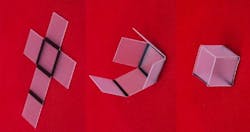Origami-inspired technique transforms 2D objects into 3D upon light exposure
Raleigh, NC--North Carolina State University (NC State) is leading amulti-university research team to develop methods that transform (by folding) two-dimensional (2D) photoresponsive materials into three-dimensional (3D) objects when exposed to light. The origami-inspired effort is funded by a grant from the National Science Foundation (NSF) and has a broad range of potential applications. Specifically, the researchers plan to use experiments and computational models to evaluate the folding process in order to develop new multi-functional 3D structures that can form rapidly while retaining precise control over their shape. Because the patterns will be on 2D materials, the process should be compatible with high-throughput patterning techniques such as roll-to-roll patterning or printing used in electronics manufacturing.
"We're pulling together a diverse team of designers, engineers and mathematicians to advance our understanding of how to manipulate photoresponsive materials," says Jan Genzer, Celanese Professor of Chemical and Biomolecular Engineering at NC State and the primary investigator under the NSF grant. "Ultimately, we hope to develop new techniques that have applications ranging from electronics to high-volume manufacturing to the delivery of humanitarian relief." The NSF grant is for approximately $1.76 million over four years.
The research effort builds on earlier research from NC State, inspired by origami, which detailed a simple way to convert 2D patterns into 3D objects using only light. In that work, the researcher ran pre-stressed plastic sheets through a conventional inkjet printer to print bold black lines on the material. The material was then cut into a desired pattern and placed under an infrared light, such as a heat lamp. Because the bold black lines absorbed more energy than the rest of the material, the plastic contracted—creating a hinge that folded the sheets into 3D shapes.
Potential applications include the development of unfoldable air foils that could be used for airdrops of humanitarian supplies with greater precision; hands-free assembly of electronics in a "clean" environment; or various packaging and manufacturing processes.
The research team includes Genzer; Michael Dickey, assistant professor of chemical and biomolecular engineering at NC State; Yong Zhu, assistant professor of mechanical and aerospace engineering at NC State; Susan Brandeis, Distinguished Professor of Art and Design at NC State; Alan Russell of Elon University, who has studied origami for more than 30 years; Emily Beck of Meredith College; and Rich Vaia of the Air Force Research Laboratory. The grant will also support four to five graduate students and post-doctoral research associates.
The grant is being funded through NSF's Office of Emerging Frontiers in Research and Innovation, and is supported in part by funds from the Air Force Office of Scientific Research.
SOURCE: North Carolina State University; http://news.ncsu.edu/releases/wms-genzer-origami-grant/

Gail Overton | Senior Editor (2004-2020)
Gail has more than 30 years of engineering, marketing, product management, and editorial experience in the photonics and optical communications industry. Before joining the staff at Laser Focus World in 2004, she held many product management and product marketing roles in the fiber-optics industry, most notably at Hughes (El Segundo, CA), GTE Labs (Waltham, MA), Corning (Corning, NY), Photon Kinetics (Beaverton, OR), and Newport Corporation (Irvine, CA). During her marketing career, Gail published articles in WDM Solutions and Sensors magazine and traveled internationally to conduct product and sales training. Gail received her BS degree in physics, with an emphasis in optics, from San Diego State University in San Diego, CA in May 1986.
